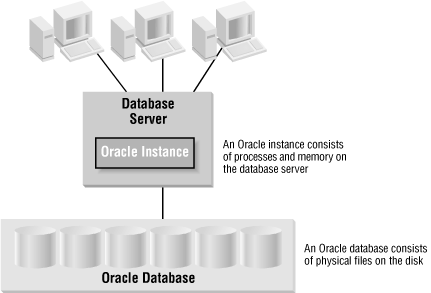Chapter 2. Oracle Architecture
This chapter focuses on the concepts and structures at the core of the Oracle database. When you understand the architecture of the Oracle server, you’ll have a context for analyzing the rest of thefeatures of Oracle.
Instances and Databases
Many Oracle practitioners use the terms “instance” and “database” interchangeably. In fact, an instance and a database are different (but related) entities. This distinction is important because it provides insight into Oracle’s architecture.
In Oracle, the term database refers to the physical storage of information, and the term instance refers to the software executing on the server that provides access to the information in the database. The instance runs on the computer or server; the database is stored on the disks attached to the server. Figure 2-1 illustrates this relationship.

Figure 2-1. An instance and a database
The database is physical: it consists of files stored on disks. The instance is logical: it consists of in-memory structures and processes on the server. An instance can connect to one and only one database. Instances are temporal, but databases, with proper maintenance, last forever.
Users do not directly access the information in an Oracle database. Instead, they pass requests for information to an Oracle instance.
The real world provides a useful analogy for instances and databases. An instance ...
Get Oracle Essentials: Oracle9i, Oracle8i and Oracle8, Second Edition now with the O’Reilly learning platform.
O’Reilly members experience books, live events, courses curated by job role, and more from O’Reilly and nearly 200 top publishers.

